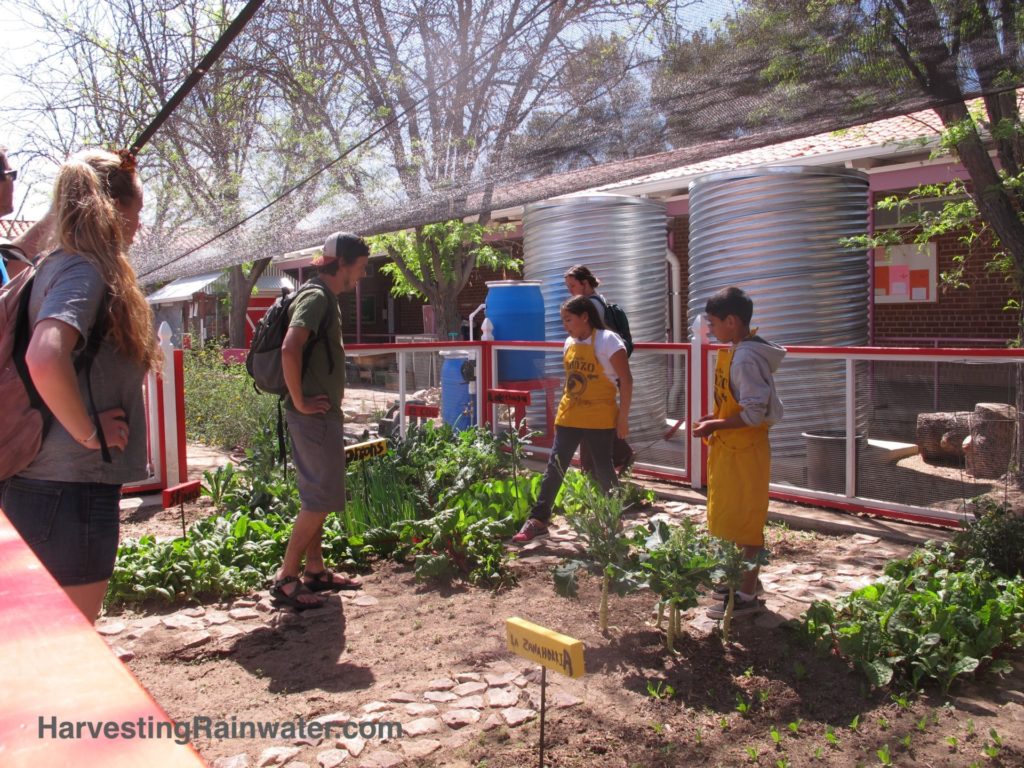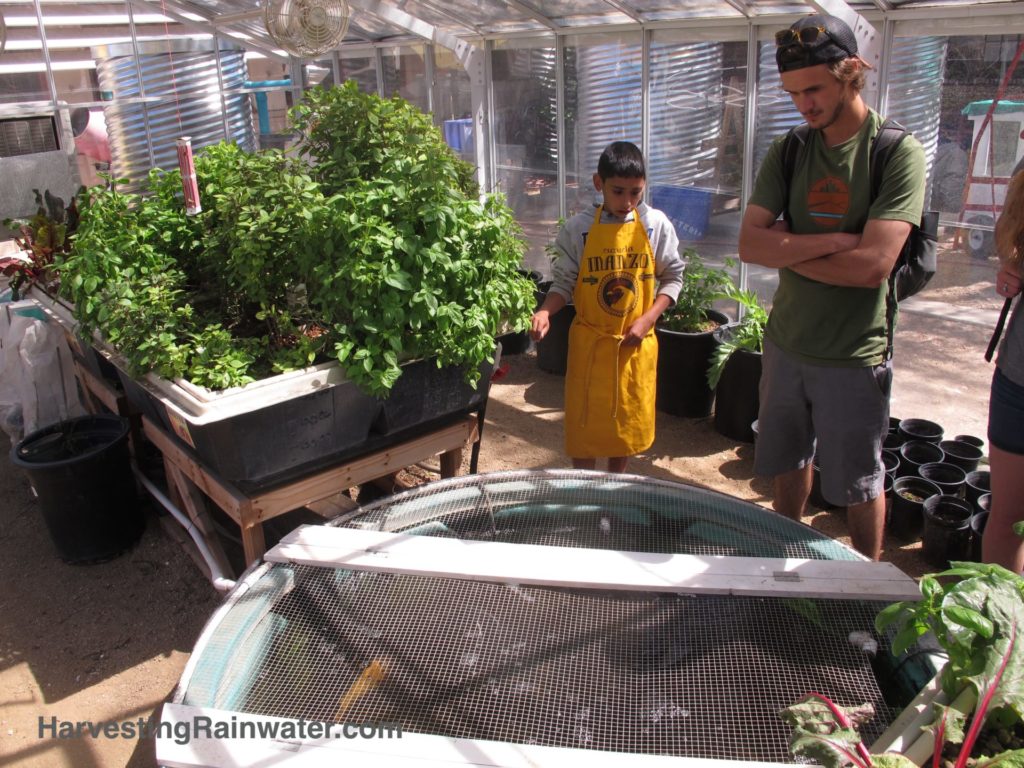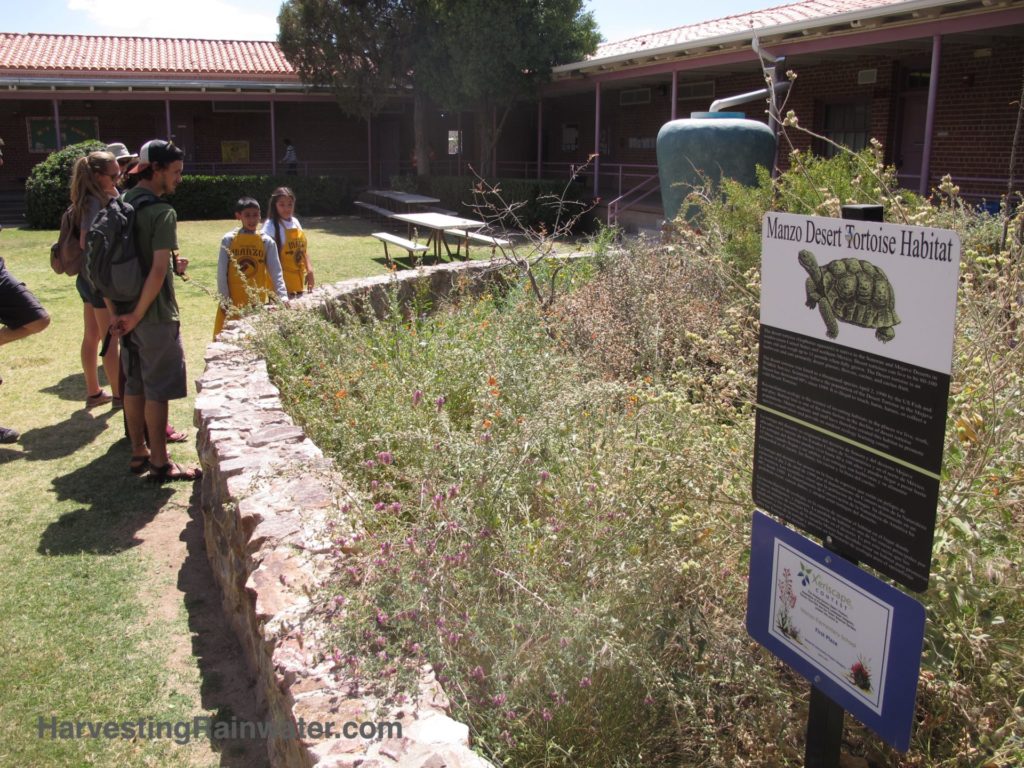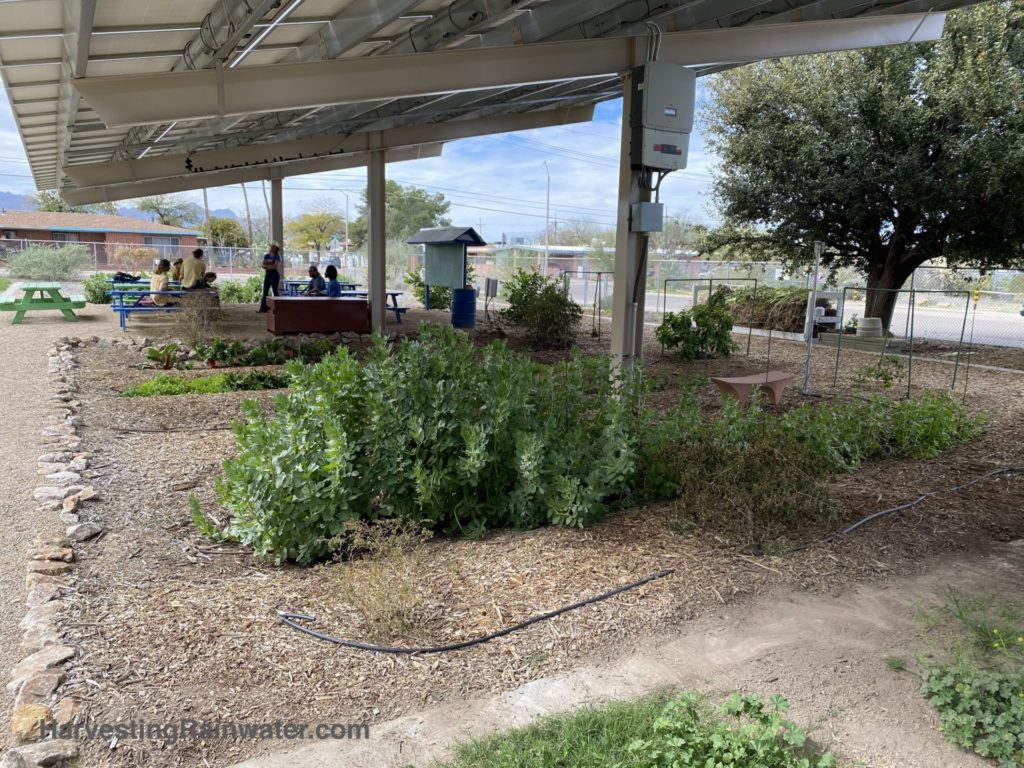Manzo Elementary School
I wish I had gone to this neighborhood school as a kid. Opportunities for playful learning through hands-on doing abound. At the core, it’s their garden and ecology program—integrated into both the curriculum and campus—that draws me in. It has transformed much of the school campus and how kids learn. What used to be a monoculture of turf, now flourishes with a desert biome garden, desert tortoises within an oasis of their natural habitat, chickens producing lots of eggs, vegetable garden, a small heritage fruit tree orchard, a school wide composting program, an aquaponics system raising fish for sale and consumption, and a nursery of heirloom crops. The kids help build, study, and manage many of these systems, and sell the resulting produce. The kids also help set the prices in their math classes by figuring out all the costs that went into each item of garden produce. Neighborhood families receive school-grown produce for free. Actively and passively harvested rainwater provides 90% of the water for all of this production (kids helped size and design the systems in their classes). The kids I talk to here, love coming to school and feel proud of it. And many of them are expert tour guides (they apprentice and train for this role) for the myriad people that come to tour their work.

Photo: Brad Lancaster, 3-27-2014
Rainwater is the primary water source of the gardens
Sixteen gravity-fed rainwater cisterns, each averaging around 1,000-gallon (3,700-liter) capacity, spread around the campus, are used by the students to hand water the garden spaces. Even the chickens have their own cistern collecting water off the chicken coop roof. That coop cistern provides the chickens with their drinking water.
Since some of the produce grown by the students with harvested roof runoff goes to school’s cafeteria, there were early concerns by the school district of the quality of the rainwater.
So, the school’s garden and ecology program coordinator worked a PHD post doc in microbiology to do extensive testing of the water in the school’s rainwater tanks over the course of a year, and all was found to be safe.
Now with all the food production you might think the water bill would be high, but according to Blue Baldwin, the former ecology coordinator, Manzo has one of the lowest water bills of school landscapes in the district. This was made possible with all the water harvesting, and also by replacing water-consumptive turf from many areas of the campus with native plantings and food growing.

Photo: Brad Lancaster, 3-27-2014
So how did this transformation begin?
In 2006 Moses Thompson was hired as the school counselor, and he quickly discovered that he was far more effective with the kids if they worked outside together on a real project for which they’d have to cooperate and communicate to accomplish.
In the early days this was watering and weeding to help restore a garden across the street from the school, which had been started by a former PE teacher, and then abandoned after the passionate teacher left. As popularity of such hands-work with Mr. Thompson grew in the kids, Mr. Thompson and the kids returned to the school campus and started to build a 40-foot-long stone wall enclosure in one of the school’s previously all-turf courtyards to create a tortoise habitat garden. A small grant paid for the materials, but the labor was free and learning. Parents and grandparents of the kids helped too. Low-water-use native plants were then planted, and a water harvesting system was built to water the plants. The result is a verdant oasis and living classroom where students make direct observations for their science classes, such as how much better plants respond to, and grow with, rainwater irrigation compared to municipal water irrigation. It is also a student & community-built point of pride.

Photo: Brad Lancaster, 3-27-2014
This success, led to one project/success after another, each funded by small grants, donations, and collaborations with various community partners (see the linked audio story at bottom of this tour for more of the community collaborations). By collaborating with various teachers, the projects and their management were also developed to provide continual hands-on learning experiences. For example, the vermicomposting project teaches kids the scientific method as they collect data through observations and make their own conclusions.
Do earthworms prefer light or shade?
Do they have a front and rear end?
Which is which?
Etc.
Cumulatively, all these projects became the school’s garden and ecology program.
But all of this could’ve been put to a halt by the school district due to a perceived lack of resources. There are only four employees maintaining the grounds of 86 schools throughout the district. And there is a moratorium on planting new trees on campuses where district staff is responsible for those trees.
Seeing abundance where others see scarcity
So, a policy was put in place early on, whereby if the Manzo garden and ecology program alters part of the landscape, the program is responsible for maintaining it. This way, no more additional work is created for the school district.
Yet the garden and ecology program is contributing significantly to the students’ and the school’s performance. Prior to the garden and ecology program, the school had a D rating, and was under-enrolled with just 250 students; which almost resulted in the school closing in 2012. Now it has a B rating, 350 students, and a waiting list of more students wanting to be enrolled.
The gardens grow
In 2014 the University of Arizona (U of A) and the Tucson Unified School District (TUSD) partnered to both sustain the Manzo program and support school garden programs across the district. A new joint-funded position was established to support gardens district wide, and a full-time coordinator was established to support the Manzo program. Today, both U of A and TUSD joint fund a team of six people who train and place about 100 University of Arizona interns per year in school gardens across TUSD, and provide ongoing professional development to teachers locally, regionally, and across the country. Moses Thompson is the current director of the U of A side of the partnership. Currently, there are over 70 school gardens across the district.
And new projects keep evolving. Manzo now has an agrophotovoltaic research program-where less-sun- and drought-hardy crops are grown in the shade under solar panels powering the school to see which crops do best. (The cooler ground and vegetation temperatures of the irrigated plants and soils below also increases the efficiency of the solar panels). This is all part of a larger research program based at the University of Arizona’s Biosphere. Chiltepines, avocados, basil, spinach, tomatoes, and fava beans are crops doing well under the solar panels.

Photo: Brad Lancaster 2-20-2020
Money earned by the garden and ecology program through market sales of its food and plants goes back into the program to pay for upkeep and repairs of the various systems.
Though unexpected needs arise. The summer of 2019 the school garden was vandalized. Fish were killed in the aquaponics, and the system needed to be rebuilt. So, Moses did social media posts on the situation.
Ray Flores, owner of El Charro restaurant threw a fundraising birthday party to fund the work. But it went further, El Charro now uses Manzo-grown produce in the restaurant, and they credit Manzo in the menus—a cool shout out for Manzo students, family, and staff.
Potential improvements:
Are there waters on site that are currently being wasted by ignoring them or draining them away?
If so, could these “waste” waters be transformed into beneficial “resource” waters?
And how might that water best be utilized and cycled to support more life, learning, and joy?
Some things that come to mind, which could be explored…
• Greywater from outside drinking fountains. Could it be directed—in sight— to plantings for free irrigation, and provide another education opportunity and example? (You can see an example of this at this site)
• Condensate from air conditioners. Could it be directed—in sight—to plantings for free irrigation, and provide another education opportunity and example? (You can see an example of this at this site)
• Street stormwater runoff and parking lot stormwater runoff. Could it be directed to plantings of street-side and parking lot-side native food-bearing trees and understory plants for free irrigation, and provide another education opportunity and example? (You can see an example of this at this site)
Manzo videos
Click here to see ASU school of sustainability video of Manzo’s school garden
Manzo Audio
Feeding Our Future: The Manzo Model for Growing a School Garden, an audio story by Arizona Public Media
Where:
855 N Melrose Ave, Tucson, AZ 85745
You must schedule an in-person tour in advance to tour this site – see below
32.23317354779592, -110.99238265940063
For more information: http://www.gomanzo.com/
To schedule a tour
Call 520-225-1900
This location is included in the following tours:
See the new, full-color, revised editions of Brad’s award-winning books
– available a deep discount, direct from Brad:

Volume 1
Manzo teachers and students used the calculations from this book to size their rainwater tanks based on the catchment area of roof draining rainwater to them.
But that’s just the beginning, this book is used in a number of the school’s classes and programs.

